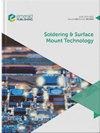Life prediction in c-Si solar cell interconnections under in-situ thermal cycling in Kumasi in Ghana
IF 1.8
4区 材料科学
Q3 ENGINEERING, ELECTRICAL & ELECTRONIC
引用次数: 2
Abstract
Purpose A numerical study on the reliability of soldered interconnects of c-Si solar photovoltaic cells has been conducted. Design/methodology/approach A three-year data (2012–2014) from outdoor weathering of PV modules was used to generate temperature cycle profiles to serve as thermal loads and boundary conditions for the investigation of the thermo-mechanical response of the soldered interconnects when subjected to real outdoor conditions using finite element analysis (FEA) Software (Ansys. 18.2). Two types of soldered interconnections, namely, Sn60Pb40 and Sn3.8Ag0.7Cu (Pb-free), were modelled in this study. Findings Life prediction results from accumulated creep energy density damage show that the solder interconnects will achieve maximum life under the 2014 thermal cycle loading. In particular, the Sn60Pb40 solder interconnection is expected to achieve 14,153 cycles (25.85 years) whilst the Pb-free solder interconnection is expected to achieve 9,249 cycles (16.89 years). Additionally, under the test region average (TRA) thermal cycle, the Pb-free and Pb-Sn solder interconnections are expected to achieve 7,944 cycles (13.69 years) and 12,814 cycles (23.4 years), respectively. The study shows that Sn60Pb40 solder interconnections are likely to exhibit superior reliability over the Pb-free solder interconnections at the test site. Practical implications This study would be useful to electronics manufacturing industry in the search for a suitable alternative to SnPb solders and also the thermo-mechanical reliability research community and manufacturers in the design of robust PV modules. Originality/value The study has provided TRA data/results which could be used to represent the test region instead of a particular year. The study also indicates that more than six thermal cycles are required before any meaningful conclusions can be drawn. Finally, the life of the two types of solders (SnPb and Pb-free) as interconnecting materials for c-Si PV have been predicted for the test region (Kumasi in sub-Saharan Africa).加纳库马西原位热循环条件下c-Si太阳能电池互连寿命预测
目的对c-Si太阳能光伏电池焊接互连的可靠性进行了数值研究。设计/方法/方法:利用光伏组件室外风化的三年数据(2012-2014)生成温度循环曲线,作为热载荷和边界条件,使用有限元分析(FEA)软件(Ansys. 18.2)研究实际室外条件下焊接互连的热机械响应。本研究模拟了两种类型的焊接互连,即Sn60Pb40和Sn3.8Ag0.7Cu (Pb-free)。基于累积蠕变能量密度损伤的寿命预测结果表明,在2014热循环载荷下,焊料互连的寿命达到最大。特别是,Sn60Pb40焊料互连预计将实现14,153个周期(25.85年),而无铅焊料互连预计将实现9,249个周期(16.89年)。此外,在测试区域平均(TRA)热循环下,无pb和Pb-Sn焊料互连预计分别达到7,944个周期(13.69年)和12,814个周期(23.4年)。研究表明,在测试现场,Sn60Pb40焊料互连可能比无铅焊料互连表现出更高的可靠性。实际意义:这项研究将有助于电子制造业寻找合适的SnPb焊料替代品,也有助于热机械可靠性研究界和制造商设计坚固的光伏模块。独创性/价值本研究提供的TRA数据/结果可用于代表测试区域而不是特定年份。该研究还表明,在得出任何有意义的结论之前,需要六个以上的热循环。最后,预测了两种类型的焊料(SnPb和无pb)作为c-Si PV互连材料的寿命,用于测试区域(撒哈拉以南非洲的Kumasi)。
本文章由计算机程序翻译,如有差异,请以英文原文为准。
求助全文
约1分钟内获得全文
求助全文
来源期刊

Soldering & Surface Mount Technology
工程技术-材料科学:综合
CiteScore
4.10
自引率
15.00%
发文量
30
审稿时长
>12 weeks
期刊介绍:
Soldering & Surface Mount Technology seeks to make an important contribution to the advancement of research and application within the technical body of knowledge and expertise in this vital area. Soldering & Surface Mount Technology compliments its sister publications; Circuit World and Microelectronics International.
The journal covers all aspects of SMT from alloys, pastes and fluxes, to reliability and environmental effects, and is currently providing an important dissemination route for new knowledge on lead-free solders and processes. The journal comprises a multidisciplinary study of the key materials and technologies used to assemble state of the art functional electronic devices. The key focus is on assembling devices and interconnecting components via soldering, whilst also embracing a broad range of related approaches.
 求助内容:
求助内容: 应助结果提醒方式:
应助结果提醒方式:


